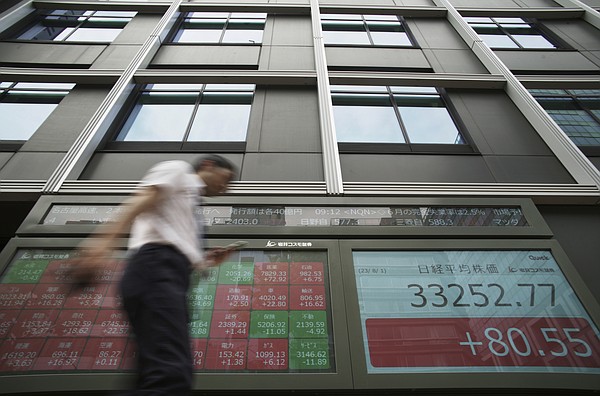NEW YORK — A sharp drop for Wall Street capped a day of declines around the world Tuesday after discouraging data on China raised worries about the global economy.
The S&P 500 slumped 1.2% for one of its worst drops since the spring after data showed a deepening slump for the world’s second-largest economy. The Dow Jones Industrial Average and the Nasdaq composite each fell 1%.
Coming into this year, the expectation was that China’s economy would grow enough after the government removed anti-covid restrictions to prop up a global economy weakened by high inflation. But China’s recovery has faltered so much that it unexpectedly cut a key interest rate on Tuesday and skipped a report on how many of its younger workers are unemployed.
Worries about the effects for the rest of the global economy are weighing on Wall Street, where stocks have already been retrenching in August. The pullback follows a gangbusters first seven months of the year that critics called overdone.
In the U.S., the economy has remained more resilient than expected despite higher interest rates. A report on Tuesday showed growth for sales at U.S. retailers accelerated by more in July than economists expected.
“U.S. retail sales are charging ahead, and a lot of that may be on charge cards,” said Brian Jacobsen, chief economist at Annex Wealth Management. “Still, the U.S. consumer is showing few signs of slowing down.”
The strong retail sales report raises hopes that the U.S. economy can keep growing and avoid a long-predicted recession. But on the downside for markets, it could also raise the Federal Reserve’s resolve to keep interest rates high in order to fully grind down inflation.
The Fed has already raised its key interest rate to the highest level in more than two decades. High rates work by bluntly dragging on the entire economy and hurting prices for investments.
“Numbers like today’s just make it more likely that rates will remain higher for longer, even if the Fed doesn’t hike them next month,” said Mike Loewengart, head of model portfolio construction at Morgan Stanley Global Investment Office.
Treasury yields initially rose following the retail sales report, approaching their highest levels since the 2007-09 Great Recession, before jostling up and down.
A faltering Chinese economy could mean less demand for oil and other commodities.
The price for a barrel of U.S. crude oil dropped $1.52 to $80.99. Prices also fell for Brent crude, the international standard, and for copper.
The declines meant stocks of energy producers were among the biggest losers in the S&P 500. Exxon Mobil’s 2.6% drop was one of the heavier weights on the index.
Bank shares also sank, continuing a rocky run since the high-profile failures of several during the spring that were caused in part by high interest rates.
Smaller and midsized banks have been under particular scrutiny from investors and credit-rating analysts, and Comerica, Zions Bancorp and Citizens Financial Group all fell at least 4.4% for some of the sharper losses in the S&P 500.
The largest loss came from Discover Financial Services. The shares dropped 9.4% after it said its chief executive is stepping down, effective immediately.
Elsewhere on Wall Street, more reports on corporate profits that came in better than expected helped to limit the market’s losses.
Home Depot gained 0.7% after it topped expectations for both revenue and profit, though it’s feeling the effects of much higher interest rates. The home improvement retailer said it’s seeing continued pressure on some types of big-ticket projects.
Stocks of homebuilders were also among the limited number of winners after Warren Buffett’s Berkshire Hathaway disclosed it bought stakes in several. Other investors often try to copy the famed investor’s moves, and D.R. Horton rose 2.9%. It was one of just 43 stocks in the S&P 500 that rose, as more than 90% within the index fell.
All told, the S&P 500 fell 51.86 points to 4,437.86. The Dow dropped 361.24 to 34,946.39, and the Nasdaq sank 157.28 to 13,631.05.
In the bond market, the yield on the 10-year Treasury rose to 4.21% from 4.20% late Monday. It helps set rates for mortgages and other important loans.
The two-year Treasury yield, which more closely follows expectations for the Fed, fell to 4.94% from 4.97%.
Information for this article was contributed by Joe McDonald, Matt Ott and Alex Veiga of The Associated Press.
Read the full article here














